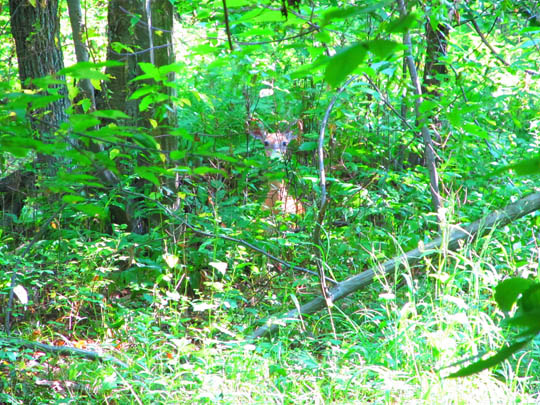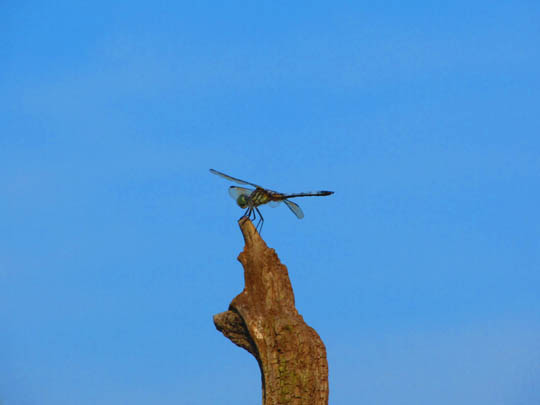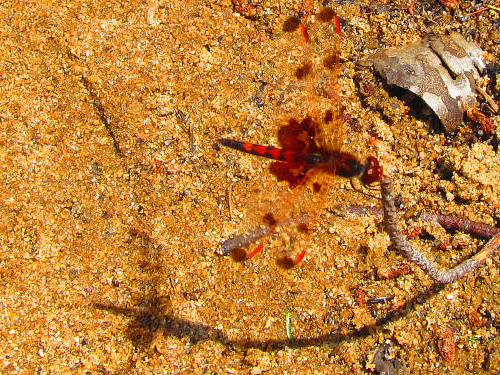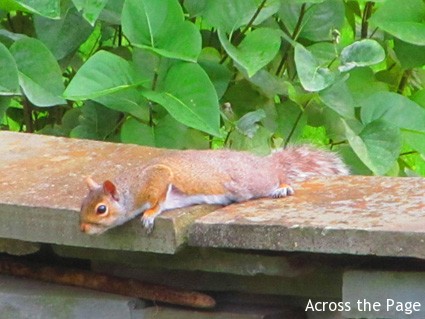Bugs, seeing, and the writing process
We’ve been bugged.
That is, the heat wave seemed to herald the entry of various bugs who made it through the screens — or the holes in the screens — at night. One morning, I discovered this fellow observing me from the bathroom wall. I have no idea what he is.
He was too pretty a green, and too big, to crush — so we took him outside.
I’ve also seen all variety of dragonflies lately. Here are a few of them.

Unbelievable how much variety there is in just this one quite small category of life. It reminds me of a passage in Zen and the Art of Motorcycle Maintenance. The passage is about the experience of a writing teacher and a student; I used to read it to my own students when we discussed the importance of a specific thesis statement. But it conveys a truth that applies not just to writing, but to all of life: the more narrowly you focus, the more you see.
He’d been having trouble with students who had nothing to say. At first he thought it was laziness but later it became apparent that it wasn’t. They just couldn’t think of anything to say.
One of them, a girl with strong-lensed glasses, wanted to write a 500-word essay about the United States. He was used to the sinking feeling that comes from statements like this, and suggested without disparagement that she narrow it down to just Bozeman.
When the paper came due she didn’t have it and was quite upset. She had tried and tried but she just couldn’t think of anything to say…
It just stumped him. Now he couldn’t think of anything to say. A silence occurred, and then a peculiar answer: “Narrow it down to the main street of Bozeman.” It was a stroke of insight.
She nodded dutifully and went out. But just before her next class she came back in real distress, tears this time, distress that had obviously been there for a long time. She still couldn’t think of anything to say, and couldn’t understand why, if she couldn’t think of anything about all of Bozeman, she should be able to think of something about just one street.
He was furious. “You’re not looking!” he said. A memory came back of his own dismissal from the University for having too much to say. For every fact there is an infinity of hypotheses. The more you look the more you see. She really wasn’t looking and yet somehow didn’t understand this.
He told her angrily, “Narrow it down to the front of one building on the main street of Bozeman. The Opera House. Start with the upper left-hand brick.”
Her eyes, behind the thick-lensed glasses, opened wide.
She came in the next class with a puzzled look and handed him a five-thousand-word essay on the front of the Opera House on the main street of Bozeman, Montana. “I sat in the hamburger stand across the street,” she said, “and started writing about the first brick, and the second brick, and then by the third brick it all started to come and I couldn’t stop…”
I think it’s time to read this book again.










6 Comments
Barbara H.
I might have to give that one a try, too.
That first little insect looks luminescent.
Thanks for your comments on WIW. It looks like there is sufficient interest to keep it going.
Carrie, Reading to Know
=X
I could live in a bug-free world and be quite happy.
Amy @ Hope Is the Word
How have I missed this book in my teacher-of-writing “career” (modest though it is)?
Janet
It’s not primarily a book about writing. It’s “an inquiry into values.” To be honest, I really don’t remember much beyond this passage I’ve often returned to — I truly do need to read it again!
Dennis King
Thank you for this quote. It is helping me think about focus as it relates to my preaching and writing. As the popular adage goes, “Less is (often) more.”
Janet
Glad you liked it!